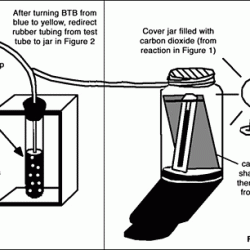Source Institutions
Source Institutions
Add to list Go to activity
Activity link broken? See if it's at the internet archive

Learners observe two model atmospheres -- one with normal atmospheric composition and another with an elevated concentration of carbon dioxide. These two model atmospheres are exposed to light energy from a sunny window or from a lamp. This activity will help learners understand that greenhouse gases in the atmosphere absorb and hold heat, relating to global warming and climate change.
- 30 to 45 minutes
- 45 to 60 minutes
- $5 - $10 per group of students
- Ages 14 - 18
- Activity, Experiment/Lab Activity, Lesson/Lesson Plan, Model
- English
Quick Guide
Materials List (per group of students)
- Student worksheets
- 15 ml of Bromothymol Blue (BTB), an indicator for acid and carbon dioxide
- 1 small beaker or jar
- 2 large jars with lids
- 2 pieces of black construction paper of equal size to place inside the jars
- 2 thermometers to place inside the jars
- 1 Erlenmeyer flask (250-500 ml)
- 1 one hole stopper for above flask
- 1 straight piece of glass tubing
- 1 50cm piece of flexible tubing (aquarium air tubing works fine)
- 100 ml of vinegar
- 4 heaping teaspoons of baking soda
- watches or classroom clock to time readings
- lamp with 100 watt bulb or sunny window sill
Subjects
-
Earth and Space Science
-
Earth Processes
- Weather and Climate
-
Earth Structure
- Atmosphere
-
Earth Processes
-
Engineering and Technology
-
Engineering
- Environmental Engineering
-
Engineering
-
Life Sciences
-
Ecology
- Human Impact
-
Ecology
-
Mathematics
-
Data Analysis and Probability
- Data Analysis
- Data Collection
- Data Representation
-
Measurement
- Rate
-
Data Analysis and Probability
-
Physical Sciences
-
Heat and Thermodynamics
- Heat and Temperature
- Heat Transfer
-
Chemistry
- Chemical Reactions
- Acids and Bases
-
States of Matter
- Gases
-
Heat and Thermodynamics
-
The Nature of Science
-
Science and Society
- Risks and Benefits
-
The Scientific Process
- Asking Questions
- Conducting Investigations
- Gathering Data
- Formulating Explanations
- Communicating Results
-
Science and Society
-
The Nature of Technology
-
Technology and Society
- Technology and the Environment
-
Technology and Society
Informal Categories
- Model Building
- Nature and Environment
Audience
To use this activity, learners need to:
- see
- see color
- read
- touch
Learning styles supported:
- Involves teamwork and communication skills
- Uses STEM to solve real-world problems
- Involves hands-on or lab activities
Other
This resource is part of:
Access Rights:
- Free access
By:
Rights:
- All rights reserved, American Museum of Natural History, 2008
